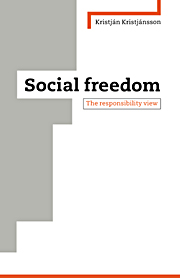Book contents
- Frontmatter
- Contents
- Acknowledgements
- 1 Introduction: freedom from Berlin onwards
- 2 Negative freedom: the nature of constraints
- 3 Obstacles and their weight
- 4 The test of moral responsibility
- 5 Internal bars and positive liberty
- 6 Freedom and power
- 7 Observations on method
- 8 Concluding remarks
- Bibliography
- Index
3 - Obstacles and their weight
Published online by Cambridge University Press: 31 March 2010
- Frontmatter
- Contents
- Acknowledgements
- 1 Introduction: freedom from Berlin onwards
- 2 Negative freedom: the nature of constraints
- 3 Obstacles and their weight
- 4 The test of moral responsibility
- 5 Internal bars and positive liberty
- 6 Freedom and power
- 7 Observations on method
- 8 Concluding remarks
- Bibliography
- Index
Summary
In the preceding chapter, the problem of what is to count as a constraint on freedom in the negative model led to the conclusion that a necessary condition of a constraint is that an agent is morally responsible for its existence. Thus, a responsibility view of freedom emerged as the most promising version of negative liberty. As yet, I hesitate to say the responsibility view, since we shall see in the sequel that the ideas expressed by different responsibility theorists sometimes conflict in important respects.
For any such view to be viable, many pressing questions about the nature of moral responsibility need to be answered. How far does it extend? How uncontroversial can it be? For the most part, these problems will be left to subsequent chapters. Here in chapter 3, I shall focus on a question that may not be as profound, but still demands an answer. Somebody might say: a definition of a constraint requires two necessary conditions of which you have furnished one – regarding its nature. But the remaining question is how weighty or serious must an obstacle be to count as a constraint? Might there not, for instance, be obstacles which satisfy the responsibility condition but are simply too small or trivial to count as constraints?
- Type
- Chapter
- Information
- Social FreedomThe Responsibility View, pp. 38 - 62Publisher: Cambridge University PressPrint publication year: 1996



